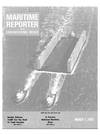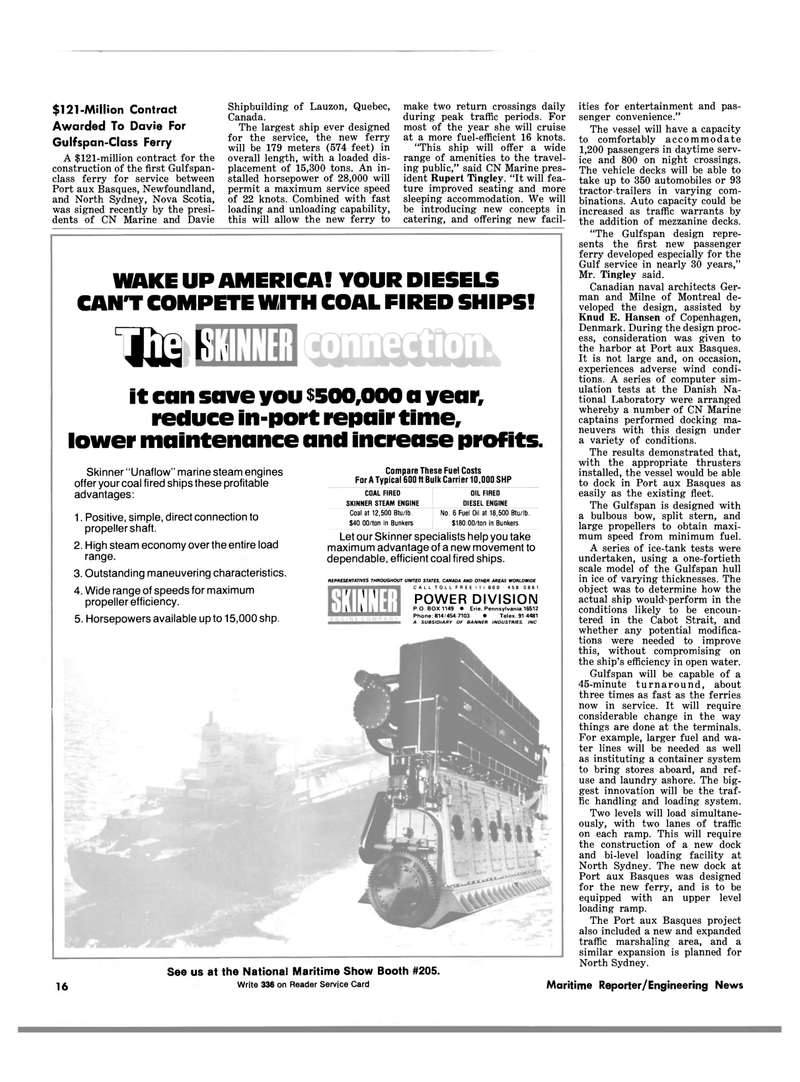
Page 14: of Maritime Reporter Magazine (March 1983)
Read this page in Pdf, Flash or Html5 edition of March 1983 Maritime Reporter Magazine
$121-Million Contract
Awarded To Davie For
Gulfspan-Class Ferry
A $121-million contract for the construction of the first Gulfspan- class ferry for service between
Port aux Basques, Newfoundland, and North Sydney, Nova Scotia, was signed recently by the presi- dents of CN Marine and Davie
Shipbuilding of Lauzon, Quebec,
Canada.
The largest ship ever designed for the service, the new ferry will be 179 meters (574 feet) in overall length, with a loaded dis- placement of 15,300 tons. An in- stalled horsepower of 28,000 will permit a maximum service speed of 22 knots. Combined with fast loading and unloading capability, this will allow the new ferry to make two return crossings daily during peak traffic periods. For most of the year she will cruise at a more fuel-efficient 16 knots. "This ship will offer a wide range of amenities to the travel- ing public," said CN Marine pres- ident Rupert Tingley. "It will fea- ture improved seating and more sleeping accommodation. We will be introducing new concepts in catering, and offering new facil-
WAKE UP AMERICA! YOUR DIESELS
CANT COMPETE WITH COAL FIRED SHIPS!
USE £ it can save you $500,000 a year, reduce in-port repair time, lower maintenance and increase profits.
Skinner "Unaflow" marine steam engines offer your coal fired ships these profitable advantages: 1. Positive, simple, direct connection to propeller shaft. 2. High steam economy over the entire load range. 3. Outstanding maneuvering characteristics. 4. Wide range of speeds for maximum propeller efficiency. 5. Horsepowers available up to 15,000 shp.
Compare These Fuel Costs
For A Typical 600 ft Bulk Carrier 10,000 SHP
COAL FIRED OIL FIRED
SKINNER STEAM ENGINE DIESEL ENGINE
Coal at 12,500 Btu/lb. No 6 Fuel Oil at 18,500 Btu/lb. $40.00/ton in Bunkers $180.00/ton in Bunkers
Let our Skinner specialists help you take maximum advantage of a new movement to dependable, efficient coal fired ships.
REPRESENTATIVES THROUGHOUT UNITED STATES, CANADA AND OTHER AREAS WORLDWIDE
CALL TOLL FREE Mi 800 458 0861
POWER DIVISION
P.O. BOX 1149 • Erie, Pennsylvania 16512
Phone 814/454 7103 • Telex 91 4481
A SUBSIDIARY OF BANNER INDUSTRIES. INC ! | ! \ \ 16
See us at the National Maritime Show Booth #205.
Write 336 on Reader Service Card ities for entertainment and pas- senger convenience."
The vessel will have a capacity to comfortably accommodate 1,200 passengers in daytime serv- ice and 800 on night crossings.
The vehicle decks will be able to take up to 350 automobiles or 93 tractor-trailers in varying com- binations. Auto capacity could be increased as traffic warrants by the addition of mezzanine decks. "The Gulfspan design repre- sents the first new passenger ferry developed especially for the
Gulf service in nearly 30 years,"
Mr. Tingley said.
Canadian naval architects Ger- man and Milne of Montreal de- veloped the design, assisted by
Knud E. Hansen of Copenhagen,
Denmark. During the design proc- ess, consideration was given to the harbor at Port aux Basques.
It is not large and, on occasion, experiences adverse wind condi- tions. A series of computer sim- ulation tests at the Danish Na- tional Laboratory were arranged whereby a number of CN Marine captains performed docking ma- neuvers with this design under a variety of conditions.
The results demonstrated that, with the appropriate thrusters installed, the vessel would be able to dock in Port aux Basques as easily as the existing fleet.
The Gulfspan is designed with a bulbous bow, split stern, and large propellers to obtain maxi- mum speed from minimum fuel.
A series of ice-tank tests were undertaken, using a one-fortieth scale model of the Gulfspan hull in ice of varying thicknesses. The object was to determine how the actual ship would^perform in the conditions likely to be encoun- tered in the Cabot Strait, and whether any potential modifica- tions were needed to improve this, without compromising on the ship's efficiency in open water.
Gulfspan will be capable of a 45-minute turnaround, about three times as fast as the ferries now in service. It will require considerable change in the way things are done at the terminals.
For example, larger fuel and wa- ter lines will be needed as well as instituting a container system to bring stores aboard, and ref- use and laundry ashore. The big- gest innovation will be the traf- fic handling and loading system.
Two levels will load simultane- ously, with two lanes of traffic on each ramp. This will require the construction of a new dock and bi-level loading facility at
North Sydney. The new dock at
Port aux Basques was designed for the new ferry, and is to be equipped with an upper level loading ramp.
The Port aux Basques project also included a new and expanded traffic marshaling area, and a similar expansion is planned for
North Sydney.
Maritime Reporter/Engineering News

 13
13

 15
15
